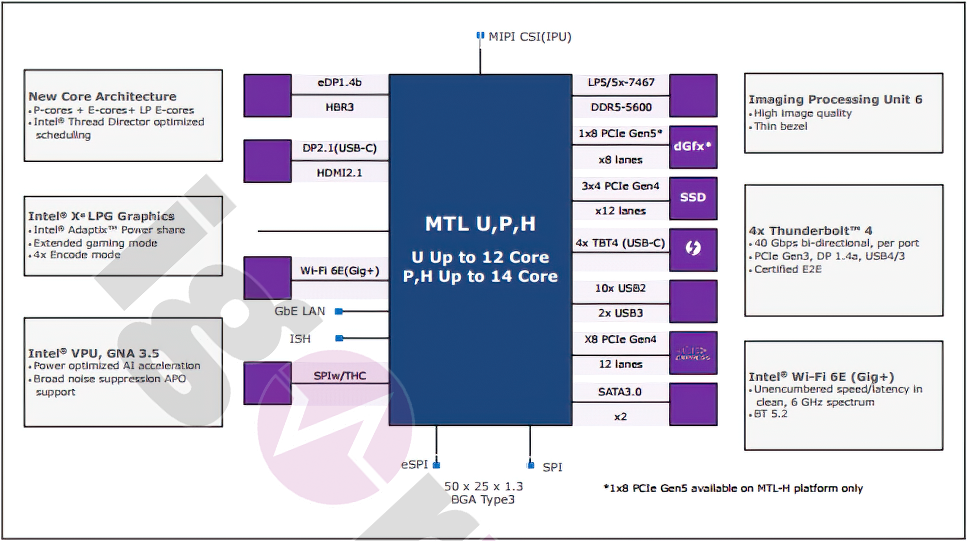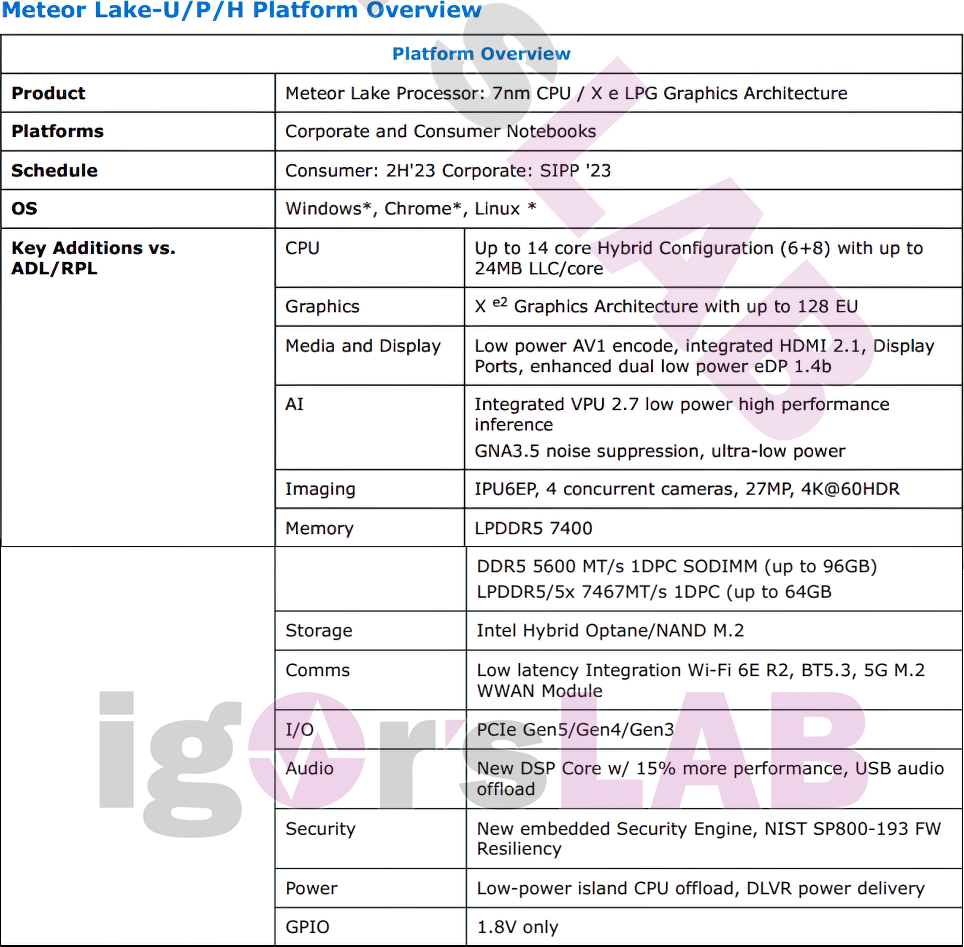Intel's Meteor Lake Mobile Detailed: Up to 14 Cores, Xe-HPG GPU, Intel 4
Intel on track to significantly advance its mobile platforms in 2023.
A high-level overview of Intel's 14th Generation Core 'Meteor Lake' platform for mobile PCs obtained by Igor's Lab shows massive advancements that the company plans to bring to the market next year.
Intel's 14th Generation Core "Meteor Lake" processors will be the company's first client CPUs to feature a multi-tiled design, as well as the first product to be made using its Intel 4 fabrication process. But the company has never detailed what is under the hood of its Meteor Lake platform.
Intel's Meteor Lake-U/P/H mobile processors will consist of four tiles — the compute tile (CPU cores) made using Intel 4 process technology (aka 7 nm EUV), the graphics tile produced by TSMC using its N3 node, the SoC tile and the I/O tile — on the same interposer interconnected between each other using the company's Foveros 3D technology.
CPU: Redwood Cove, Crestmont, and Low-Power E-Cores
The CPU tile is arguably the most intriguing feature, as it will contain up to six high-performance Redwood Cove P-cores as well as up to eight energy-efficient Crestmont general-purpose E-cores implemented using Intel 4, as seen on Meteor Lake's compute tile die shot. Meanwhile, a slide replicated by Igor's Lab indicates that the platform will also feature the so-called low-power energy-efficient cores. Mainstream Meteor Lake-U cores will feature up to 12 cores, whereas Meteor Lake-P and Meteor Lake-H will have up to 14 cores activated.
Interestingly, Twitter leaker @OneRaichu claims that there are two LP E-cores and that they are located in the SoC tile implemented using a low-power fabrication process. Considering the fact that Meteor Lake's compute tile has eight E-cores, it is unclear whether LP E-cores are included in the total core count for the platform and whether they will be present in Meteor Lake-P/H SKUs (and this is all unofficial, so we should take it all with a grain of salt anyway). Yet, having ultra-low-power general-purpose CPU cores in the SoC tile would make sense for applications that work in the background even when the PC is hibernating in connected standby mode.
It seems possible that Intel's Meteor Lake mobile platforms will have three different types of cores for higher energy efficiency, which is comparable to Arm's platforms for smartphones.
GPU: The Xe-LPG GPU Architecture
Next up is the separate graphics tile featuring the Xe-HPG/Xe-LPG architecture and up to 128 EUs produced by TSMC using its N3 fabrication process. 128 EUs at potentially high clocks could make GPU performance of Intel's Meteor Lake processor comparable to that of its own discrete Arc Alchemist A370M graphics chip.
Get Tom's Hardware's best news and in-depth reviews, straight to your inbox.
Usage of Xe-HPG architecture by Meteor Lake's graphics tile has been confirmed by one of Intel's Linux patches discovered by Coelacanth’s Dream. Meanwhile, we see the mention of Intel's Xe-LPG for the first time.
While we do not have any solid information about the Xe-LPG architecture, we can speculate that it inherits architectural capabilities of gaming-oriented Xe-HPG (for instance, hardware-accelerated ray tracing), but is implemented using low-power libraries. Furthermore, the graphics tile probably comes with low-power implementations of media processing engines and display pipelines. To some degree this is backed up by the features called 'low power AV1 encode' and 'enhanced dual low power eDP 1.4b.'
Curiously, the slides replicated by Igor's Lab mention support for HDMI 2.1 and DisplayPort 2.1 over USB-C. Meanwhile, VESA has not announced anything called DisplayPort 2.1, so either Intel plans to support an all-new standard that even has not been ratified, or this is a typo (again, we are dealing with unofficial information here).
PCIe Gen5 Support on Mobile
Currently Intel only supports PCIe 5.0 interface on its desktop 12th Generation Core 'Alder Lake' processors, whereas mobile Alder Lake-H parts only feature PCIe 4.0. With Meteor Lake-H, Intel will bring PCIe 5.0 x8 connectivity to its mobile platform to boost performance of gaming-oriented notebooks. Meanwhile, it looks like Meteor Lake-U/P will still not support PCIe 5.0.
SoC: Ultra-Fast Memory and Bult-In AI Capabilities
For years, Intel equipped its processors with its platform controller hubs (PCHs) that contained controllers as well as physical interfaces. With its 14th Generation Core "Meteor Lake" platform, the company will split PCH into two separate chiplets: the system-on-chip (SoC) chiplet responsible for controlling the whole processor and actual I/O interfaces.
The SoC tile is made using a low-power process technology to reduce power consumption of various controllers, though we do not know whether this chiplet is made in-house or by TSMC. The I/O chiplet is probably made using a very rough technology since all it does is carry interfaces like PCIe, Thunderbolt, SATA and USB that barely scale with thin nodes.
Meteor Lake's SoC tile features a new memory controller that supports up to 64GB of LPDDR5X-7467 as well as up to 96GB of DDR5-5600. There is no word about the number of channels supported.
Other interesting features of Meteor Lake's SoC tile are Intel's VPU 2.7 inference accelerator coupled with Gaussian and Neural Accelerator (GNA) 3.5 unit that is used primarily for things like noise suppression. Also, the SoC carries Intel's new embedded security engine that complies with NIST SP800-193 requirements.
Summary
Intel's 14th Generation Core "Meteor Lake" for laptops may be a breakthrough platform for the company. If the report is correct, the all-new multi-tile physical design will bring in all-new CPU and GPU microarchitectures as well as low-power E-cores. Keep in mind, however, that we are dealing with early information obtained from unofficial sources, so we'll see just what makes it to the final product. Still, Meteor Lake looks quite impressive so far.

Anton Shilov is a contributing writer at Tom’s Hardware. Over the past couple of decades, he has covered everything from CPUs and GPUs to supercomputers and from modern process technologies and latest fab tools to high-tech industry trends.
-
-Fran- It definitely reads good, that's for sure. I hope they can execute with no problems... I hope...Reply
Also, how big will the chip (whole SoC) will be? At a first glance, it may be as big as Alder Lake's interposer dimensions, which is really big for mobile. Maybe a tad smaller, but it's gonna be a beefy boy, I think.
Regards. -
shady28 That's a 1/3 jump in number of EUs on the iGPU.Reply
LPDDR5-7400?
Looks pretty sick to me (in a good way). -
cyrusfox Reply
As the iGPU is separate chip completely, (TSMC N3) will be interesting to see if we ever get configs with more than 128 (256/384/512 EU) Arc directly attached. Probably overcomplicates the chip stacking. Hope drivers can continue to mature as RDNA2 on the latest Ryzen Mobile/APU is a pretty high bar for Intel.shady28 said:That's a 1/3 jump in number of EUs on the iGPU.
LPDDR5-7400?
Looks pretty sick to me (in a good way). -
shady28 Replycyrusfox said:As the iGPU is separate chip completely, (TSMC N3) will be interesting to see if we ever get configs with more than 128 (256/384/512 EU) Arc directly attached. Probably overcomplicates the chip stacking. Hope drivers can continue to mature as RDNA2 on the latest Ryzen Mobile/APU is a pretty high bar for Intel.
Ya I wouldn't really expect it to defeat RDNA2 in any significant way, but matching it would be good. Having said that, that LPDDR5-7400 might have a big effect on iGPU performance though. There's a huge difference in iGPU performance between a Tiger Lake Xe laptop with DDR4-3200 and one with LPDDR4-4266.

